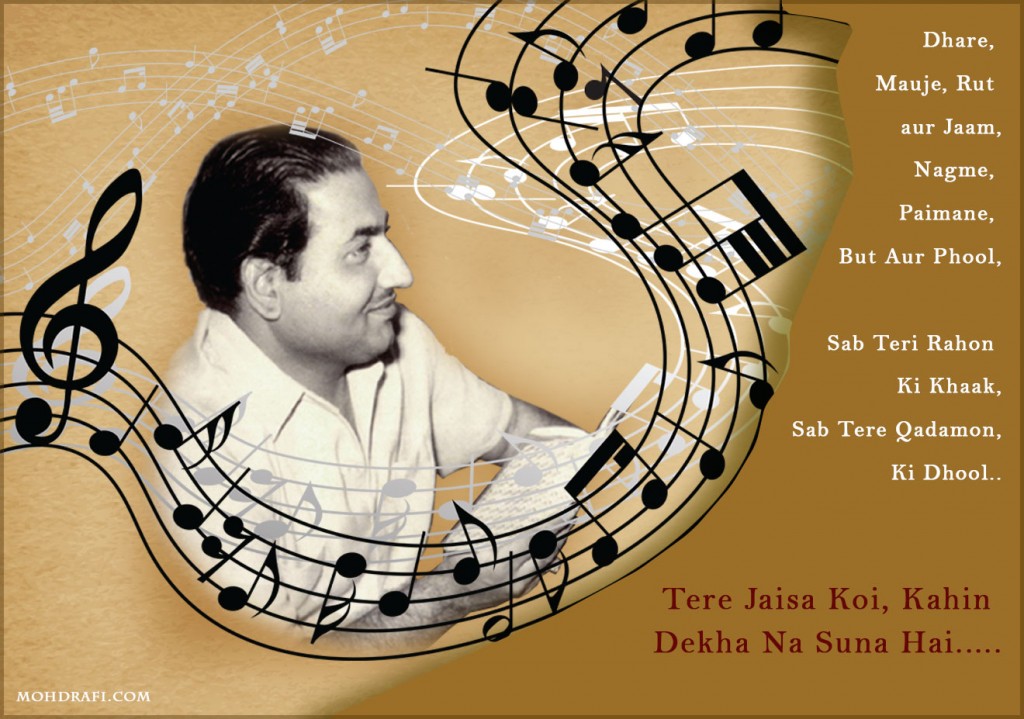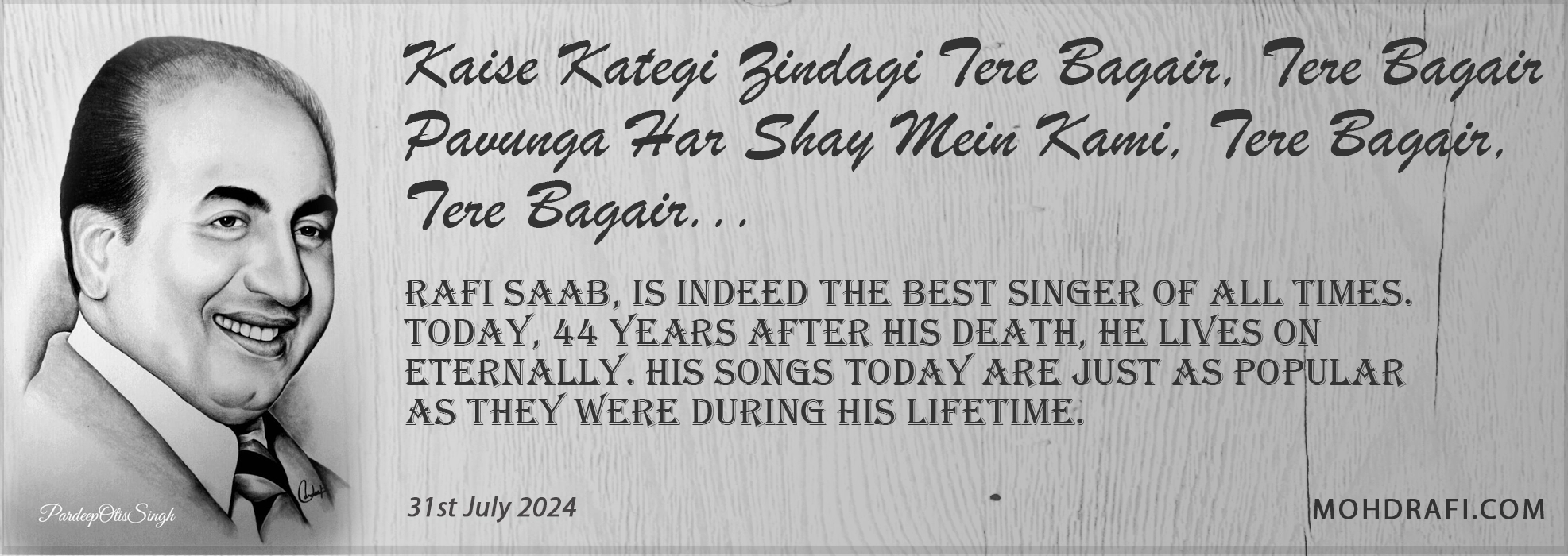Mohammed Rafi Redefined Versatility
By Jagdish K. Bhagchandani

India is a land of immense multiplicity with rich and wonderful cultural heritage. It is a country of many religious/ ethnic groups, multi-linguistic population. Various poets, artists, musicians have contributed immensely to depict the nation’s heritage and diversity through their art.
Apart from magnificent buildings and structures, paintings and sculptures of various eras and styles (that are strong symbols of India’s diversity); music has been India’s most defining form of expression of human emotions and representative of India’s rich cultural heritage. India had been a generous beneficiary of number of giants in the field of music. But one voice that cuts across all barriers of caste, creed, religion, geographical regions is the one and only one, that of Mohd. Rafi saab. He is revered not just because he belted out innumerous playback scores in so many languages to melodiously touch the various emotions of our life; but also because while doing so, he also instilled in the listener, the humanist aspects of values, patriotism and tolerance. Through his expressive renderings and universality of voice modulation he touched the very soul of India’s humanity. His was the most versatile voice that has found no match till date.
In a generic term a ‘versatile singer’ would mean the one who could render various genres of songs and do full justice to their nuance. In that sense we are fortunate to have lived in the era of galaxy of legendary singers who gave us many gems of various moods and emotions. But when it comes to Rafi saab, his versatility stretched beyond the generic definition. The varied approach he adopted to sing a particular genre for different characters, different situations was something of a marvel. For example “Jo guzar rahi hai mujh par use kaise main bataaoon……” and the song “Gam uthane ke liye main to jiye jaaoonga”: both are sad songs of same movie (Mere Huzoor), yet so different from each other. The first one is having hidden sadness of a nawabi character, and the second a regretful outcry of realization of a misguided man. How Rafi saab has brought the essence of both the situations and delivered different styles under same genre (of ‘sad songs’) is just brilliant. Another example: the loneliness and recluse nature of the hero can be felt in song “Mujhe le chalo aaj phir us gali mein jahaan pahle pahle ye dil ladkhadaya….”, and on the other hand “Kya se kya ho gaya bewafa tere pyar mein…..” is an assertive song voicing hero’s grievances towards his loved one. Rafi saab has superbly grasped the essence of both the sad songs (of different situations) and rendered them to the precision. There are examples in plenty wherein we can feel the different variants that Rafi saab has incorporated within the gamut of ‘sad songs’ to make it more specific to the situation, to the personality that would sing on screen.
Similarly we can find such splendid variations in innumerable happy songs. From sweet serenity of “Ek hasin sham ko dil mera kho gaya……” to the peppy “Dil Deke dekho….” or from classical “Akhiyan sang akhiyan laagi….” to rock and roll “Jaan Pehchan ho, jeena aasan ho….” , the list of happy songs representing different situations and characters is simply astonishing. Rafi saab sang “Koi sone ke dil wala koi chandi ke dil wala….” to portray a sophisticated yet sensitive character of Dev Anand from movie Maya. In the same movie he adopted to different voice modulation and style to make the song (Sanam tu chal diya rastaa mere bina to kya main rah nahin sakta……) representative of a care-free and comic Agha. The repository of his joyful songs is so varied and diverse that volumes and volumes can be written on this aspect. Many of his romantic songs are nothing short of iconic and a benchmark for any romanticist. How each and every song is true representation of its mood, its cinematic situation and the character that it portrays, is a substance of sheer brilliancy.
Rafi saab sung bhajans too have many moods and variables. While “Oh duniya ke rakhwale sun dard bhare mere naale…..” is an outcry of a wronged devotee, same movie song “Man tadpat hari darshan ko aaj….” is symbolic of the yearning of a devoted disciple. And what rendering!… what singing!….. voice as divine as it could be….. simply out of this world. “Badi der bhai nandlala teri raah take brijbala…..” is sung in a kirtan style, and the bhajans like “Mujhe to shiv shankar mil gaye…” and “Prabhu tere charan pade jahan jahan…” are bhajans of devotion depicting the faith and surrender-to-God sentiment. Then there are bhajans glorifying Gods (Chale bhole baba, chale Shankar baba….. or Bhajan bina bawre tune heera janm ganwaya…..). He has even recited verses of Ramayana flawlessly like a true devotee (in the movie: Tulsidas). Rafi saab’s accurate apprehending of each variation of each bhajan has resulted in such memorable and soul-stirring devotional songs.
The intent of this write-up is to highlight and celebrate the extent to which the versatility factor in Rafi saab’s body of work is perceptible through some random examples of some of the genres of playback singing. These examples are just a few drops in the ocean of Rafi Saab’s reservoir of songs. If we consider other genres like qawalis, ghazals, patriotic songs, non-filmi numbers, motivational songs etc. and within them the variety Rafi saab has instilled, the canvas of his versatility gets bigger and bigger. Each of these genres and their exploration by Rafi saab can be written about and talked about at a great length. For Rafi saab, It was not merely singing various genres, it was going further deep into the song’s inner most core and incorporate its every aspect in singing.
He created sub-genres within each genre of songs. He redefined ‘versatility’.
The musical treasury that Rafi saab has left behind him is the true reflection of India’s cultural diversity. His songs unite the nation and are true symbols of India’s pride. As a nation we owe it to him and to all the coming generations to preserve his work like it is done for any magnificent monument of historical importance.
On the 40th death anniversary of this unparalleled genius, nation’s humble tributes to the emperor of playback singing, a divine and pious soul, Mohd. Rafi.

I am go come for Gudurafi village, Gbako, Niger state, Nigeria
Marvelleous write up Jagdish bhai. You have really incorporated Ramayana & Mahabharata about Rafi saheb in only one page article itself & the conclusion “as a nation we owe it to him and to all the coming generations to preserve his work like it is done for any magnificent monument of historical importance” is absolutely true.Hats off once again for this great article.
Superb narration of the versatility of a superb singer… Only a true music lover and true can of Mind Rafi can do it. The blog gives a measure of intensity of involvement with which you listen to the songs of Rafi saheb…And the measure of pleasure you derive while listening.
A fine tribute in the form of a beautifully written passage on the great crooner Rafi Sahib like of whom the world will never see.
A big salute to the author.
An excellent usage of words to define this great legend…fantabulous weiteup on Rafisaab
Very Nice Article Sir… “Jai Rafi Sahab”